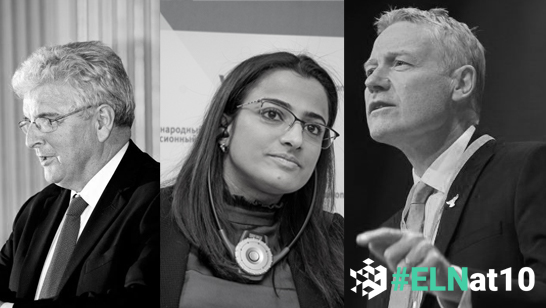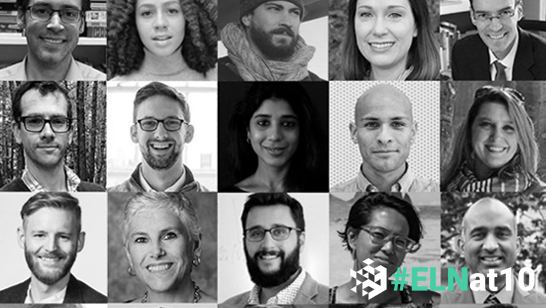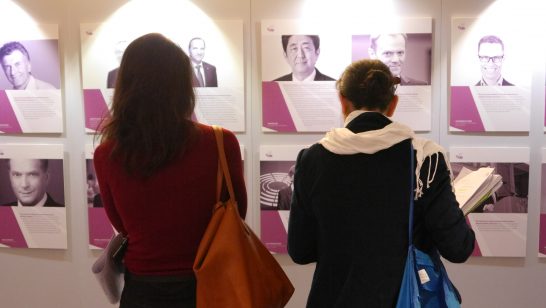

As part of the ELN’s series of reflections on our tenth anniversary, Senior Associate Fellow Heather Williams shares her personal reflections on the human side of the nuclear policy field.
Nuclear weapons are a personal matter. And one of the biggest changes in the nuclear community over the past decade, since the founding of the European Leadership Network (ELN), has been the increasingly personal nature of nuclear policy work, to include advances in diversity, an emphasis on humanitarian impacts of nuclear weapons, and greater familiarity among nuclear experts, largely thanks to social media. The increasing inclusivity and personalisation of the nuclear community is (hopefully) the direction the field is moving in, particularly in the aftermath of the pandemic in which we got a glimpse- quite literally- into each other’s private worlds.
In many ways, this development reflects a much broader shift in professional working culture- ‘bringing our full selves to work.’ As one expert on diversity and inclusion clarifies, ‘Bringing your full self to work does not mean that every part of you is laid out for all to see’, and it must include a respect for others’ views and professional appropriateness. But what does it mean to ‘bring our full selves to work’, when we work on the deadliest of weapons? This essay offers personal reflections and experiences on the evolution of the nuclear community over the past decade as it has become more fulsome, accessible, and personal. It is also an invitation for deeper thinking about how we can continue this trend to be both more inclusive and focused on the changing nature of nuclear risk.
The ELN has been an important port-of-call for me personally navigating the nuclear field by providing a 'safe space' for dialogue among diverging views across Europe, North America, and Russia. Heather Williams
The European Leadership Network has been an important port-of-call for me personally navigating the nuclear field by providing a ‘safe space’ for dialogue among diverging views across Europe, North America, and Russia. It provides exactly the type of forums and opportunities, particularly for early career researchers, we need for promoting cooperation in a rapidly changing world.
Diversity and Inclusivity
Women are much more visible in the nuclear community than ten years ago, when the ELN was founded. One example of this is the Carnegie Nuclear Policy Conference, a flagship gathering of the nuclear community: in 2009, the Conference included nine women speakers (not including chairs or opening/closing commentary) out of 56 (26%); whereas in 2019, there were 23 women out of 45 speakers (51%). Nonetheless, over the past 40 years, women have been significantly under-represented in senior leadership positions and women point to ‘lack of empowerment’ as a barrier to entry in the field of national security in the United States, but it is also a challenge in European policy debates.
With that said, I am a white woman from suburban America, and while the nuclear field may increasingly represent my background and experiences, it remains extremely pale. In 2020, 150 American national security organizations and practitioners pledged to improve diversity in their ranks, stating, ‘To root out institutional racism, it is vital that we re-examine our implicit and explicit biases, as well as biases within our organisations.’ Again, the situation in Europe is no better. Fifty million people of colour live within the European Union (EU), but as of a year ago, none of the EU’s institutions have a person of colour in a senior management role.
The nuclear community can do more to amplify the voices of under-represented practitioners willing to provide representation, and encourage groups and organisations that represent these individuals. Heather Williams
We have to do better to make the nuclear community more equitable and accessible, especially to people of colour, LGBTQ, non-neurotypical or not able-bodied, and from different socio-economic backgrounds. Many of these groups remain woefully under-represented, and as a result, people can end up feeling lonely, unwelcome, or responsible for ‘explaining’ their experiences or solving the problem themselves. Organisations such as Women of Colour Advancing Peace and Security (WCAPS), which has a UK branch and launched the initiative Orgs in Solidarity, along with the Gender Champions in Nuclear Policy Initiative offer timely and useful forums and tools for education and action. Additionally, the nuclear community can do more to amplify the voices of under-represented practitioners willing to provide representation, and encourage groups and organisations that represent these individuals. (I am incredibly grateful to Anu Damale and Alexi Drew for these suggestions and their continued willingness to answer questions and represent their communities.)
Humanitarian Impacts of Nuclear Weapons
Nowhere is this emphasis on diversity and inclusivity more noticeable than in the humanitarian impacts of nuclear weapons initiative. Indeed, this movement highlights the personal experience of a wide range of individuals whose lives were directly impacted by nuclear weapons. Thanks in large part to the humanitarian impacts conferences in 2013 and 2014, efforts by civil society organisations, and the Treaty on the Prohibition of Nuclear Weapons, these views are increasingly a part of nuclear policy discussions. As they should be.
I was first introduced to this movement in 2012 and had the privilege of attending the three humanitarian impacts conferences. The conferences included the testimony of survivors of the nuclear bombings and research on the environmental impact of nuclear testing, among other topics. For example, the Vienna conference in 2014 included the testimony of Sue Coleman-Haseldine, from the Koonibba Aboriginal Mission in Australia, that was impacted by nuclear testing in the region: ‘I remember older people talking about Nullabor dust storms. It was the fallout from the Maralinga tests. We weren’t on ground zero, but the dust didn’t stay in one place. It went wherever the winds took it. I noticed people dying of cancer, something that was new to us. There’s a cemetery at Woomera which we call the children’s cemetery. It’s filled with children who died around the time of the tests.’ The testimony of survivors of Hiroshima and Nagasaki, along with groups impacted by nuclear testing, ought to be required reading for anyone working on nuclear weapons issues.
The humanitarian impacts conferences led to the Treaty on the Prohibition of Nuclear Weapons (TPNW), and while the TPNW remains politically contentious, it should not detract from discussions on the historical human costs of nuclear weapons and nuclear testing. When the Treaty was concluded in 2017, nuclear scholars Benjamin Valentino and Scott Sagan pointed to it as a ‘missed opportunity’, because, ‘The energy, organization, and genuine passion that eventually resulted in the ban treaty were assets that might have been used to address dangerous realities about nuclear weapons that are too often ignored: the human costs of clean-up of waste sites and production facilities and the potential for nuclear winter or other environmental effects.’ Nonetheless, these conferences and the humanitarian movement have changed nuclear scholarship and discourse and brought to light an aspect of nuclear weapons policy that is often overlooked.
The humanitarian impacts conferences and the humanitarian movement have changed nuclear scholarship and discourse and brought to light an aspect of nuclear weapons policy that is often overlooked. Heather Williams
Since the first humanitarian impacts conference, ELN has provided an important platform for spreading these stories and messages, and putting them in the wider context of nuclear policy. This has included proponents of the TPNW as well as sceptics.
Familiarity
At 6:45PM on Monday, April 6, 2009, I remember exactly where I was. It was the aforementioned Carnegie Nuclear Policy Conference, and I was standing by a ficus plant in the atrium of the Ronald Reagan Convention Center. While I had exceptional mentors, as an early career researcher I rarely interacted with other senior scholars or the wider community. There just weren’t many opportunities to do so. I stood there for nearly half an hour, by myself, with a glass of room-temperature white wine, not knowing anyone.
Today, however, I suspect the community is much more welcoming and scholars across generations can regularly interact informally through social media. Initiatives such as the Young Generation Leaders Network in Euro-Atlantic Security, along with groups such as the Project on Nuclear Issues, break down barriers between next generation, mid-career, and senior practitioners. And Twitter presents a whole platform for ‘bringing your full self to work’ and reveals personal details about people we know professionally. For example, anyone who follows me on Twitter will know my husband is an Irish chef, I love buffalo wings, and I have orange lampshades. I cannot imagine knowing this kind of information about other nuclear scholars ten years ago.
But the increased use of social media over the past decade also presents unique challenges. The Presidency of Donald Trump demonstrated that a tweet is no substitute for thoughtful policy. The same can be said for nuclear analysis. A Twitter exchange is no substitute for deep dialogue. Number of Twitter followers or retweets is not necessarily an indication of meaningful or impactful work. Indeed, some of the most important thinking on nuclear issues is being done by people who are not on Twitter, such as Anastasia Malygina or Wilfred Wan. In short, there is no substitute for good work, even a clever Friends gif.
Conclusion
The three developments I point to- more diversity, the humanitarian impacts initiative, and a sense of community- are not exhaustive examples of how the nuclear field is changing, rather they are intended to start a conversation. All of these trends I believe have been extremely positive overall for enriching scholarship, building a community, and developing a more fulsome picture of the world in which we operate.
The ELN will remain at the forefront of navigating these issues for the next decade, as it did with the previous one. It represents the diversity of backgrounds, perspectives, and experiences that define the field. It provides necessary forums for a free exchange of views, often with people we might disagree with. And it is building a community of practice, particularly in the trans-Atlantic space, that has significant potential to contribute to cooperation and trust-building in nuclear policy. After all, we’re not here for the Friends gifs, but rather to save the world.
The opinions articulated above represent the views of the author(s) and do not necessarily reflect the position of the European Leadership Network or any of its members. The ELN’s aim is to encourage debates that will help develop Europe’s capacity to address the pressing foreign, defence, and security policy challenges of our time.
Image: WIIS UK



